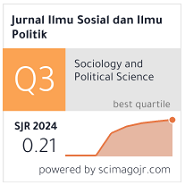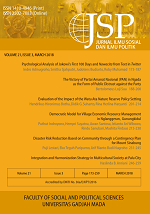The Middle-Class Muslims’ Responses Toward the Salafi Da’wah: A Study on Hijrah celebrities
Oki Setiana Dewi(1), Ahmad Khoirul Fata(2*), Mahfudh Fauzi(3)
(1) Universitas Islam Negeri (UIN) Syarif Hidayatullah Jakarta, Indonesia
(2) Institut Agama Islam Negeri (IAIN) Sultan Amai Gorontalo, Indonesia
(3) Institut Daarul Qur’an (IDAQU) Tangerang, Indonesia
(*) Corresponding Author
Abstract
This study unravels how Indonesian celebrities who submitted to Salafi Islam (popularly called hijra celebrities) responded to some notable Salafi teachings. Like in many Muslim countries, such as Türkiye, Pakistan, and Egypt, Salafism is increasingly attracting followers from the middle class who then express their Salafism in public visibility, or called “active piety”. The data for this article was collected through in-depth interviews with Salafi preachers (dais) and celebrities who actively participated in the Islamic meetings held or taught by these preachers. This study uses a cultural studies approach, in which Hall's theory of encoding-decoding is used to analyse the active role of hijrah celebrities in receiving messages conveyed by Salafi preachers. This study reveals that the Salafi preachers used the educational approach in their propagation (da’wah) through religious education forums using clear guideline books. Meanwhile, the celebrities’ responses toward this Salafi propagation varied, i.e., dominant hegemony, negotiation, and opposition, with negotiation being the most frequent. In general, the celebrities accepted the Islamic teachings from their Salafi teachers, except for several issues that they considered less relevant to their lives. This study also found the fact that the hijrah celebrities, as recipients of information, did not passively receive information, but they classified, selected, and utilised the information received from the Salafi preachers and adapted it to their needs.
Keywords
Full Text:
PDFReferences
Agustinus, M., & Tenu, E. T. (2021). Erick Thohir: Kelas Menengah Muslim RI Makin Besar di 2025. Kumparan. https://kumparan. com/kumparanbisnis/erick-thohir-kelas-menengah-muslim-ri-makin-besar-di-2025-1x5f0ASdDXD/full
Ali, H., & Purwandi, L. (2017a). Indonesia Middle Class Muslim: Religiosity and Consumerism. Alvara Research Center. https://alvara-strategic.com/wp-content/uploads/whitepaper/Indonesian-Middle- Class-Muslim.pdf
Ali, H., & Purwandi, L. (2017b). The Urban Middle-Class Millenials Indonesia: Financial and Online Behavior. Alvara Research Center. https://alvara-strategic.com/wp-content/ uploads/whitepaper/The-Urban-Middle-Class-Millenials.pdf
Aligwe, H. N., Nwafor, K. A., & Alegu, J. C. (2018). Stuart Hall’s Encoding-Decoding Model: A Critique. World Applied Sciences Journal, 36(9), 1019–1023. https://doi. org/10.5829/idosi.wasj.2018.1019.1023
Azra, A. (2011, December 29). Kelas Menengah Muslim Indonesia (1). Republika.
Azra, A. (2017). Kelas Menengah Muslim Indonesia: Sebuah Pengantar. In W. R. Jati (Ed.), Politik Kelas Menengah Muslim Indonesia. Depok: LP3ES.
Azra, A. (2018, February 8). Pesantren Salafi (2). Republika. https://republika.co.id/berita/ kolom/resonansi/18/02/07/p3shrr440-pesantren-Salafi-2
Azra, A. (2019, August 17). Konservatisme Agama (3). Republika.
Bakti, A. F. (2004a). Communication and Family Planning in Islam in Indonesia: South Sulawesi Muslim Perceptions of Global Development Program. Leiden: INIS.
Bakti, A. F. (2004b). Nurcholish Madjid and the Paramadina Foundation. IIAS Newsletter, 34.
Bakti, A. F. (2004c). Paramadina and its Approach to Culture and Communication: an Engagement in Civil Society. Archipel, 68, 315–341.
Bakti, A. F. (2018). As-Syafi’iyah Engagement in Dakwah and the Development of BKMT for Civil Society in Indonesia.
Basalamah, K. (2016). Hukum Cadar bagi Wanita dan Apakah Punggung Telapak Tangan itu Aurat. [Video]. https://www.youtube.com/watch?v=cgk42wfYpDo&t=37s
Basalamah, K. (2017a). Hukum Mendengarkan Musik Dalam Islam. [Video]. https://www.youtube.com/watch?v=CUU-JVIHNTo&t=189s
Basalamah, K. (2017b). JADI TAHU !!! Hukum Demokrasi Dalam Islam. [Video]. https://www.youtube.com/ watch?v=CqPxLhi3XQs
Bayat, A. (2011). Pos Islamisme. Yogyakarta: LKiS.
Brown, T. (2019). The New Pakistani Middle Class, By Ammara Maqsood. Asian Studies Review, 43(2), 354–356. https://doi.org/ https://doi.org/10.1080/10357823.2019.1522688
Dewi, O. S., & Fata, A. K. (2021). Beragam Jalan Menjadi Salih: Model Dakwah Kelas Menengah Muslim Indonesia. Bimas Islam, 12(1), 1–32. https://doi.org/10.37302/jbi.v14i1.325
Dewi, O. S., & Fata, A. K. (2023). Salafi Da’wah Among Hijra Celebrities. Penamas, 36(2), 180–198. https://doi.org/10.31330/penamas.v36i2.711
Dorsey, J. M. (2022). Muslim piety in Southeast Asia mirrors increased religious traditionalism in the Middle East. https://moderndiplomacy.eu/2022/09/29/muslim-piety-in-southeast-asia-mirrors-increased- religious-traditionalism-in-the-middle-east/
Fata, A. K. (2020). Buya Hamka: Pemikiran & Perannya di Pentas Politik Nasional. Semarang: Rasail Media.
Fata, A. K., & Ichwan, M. N. (2017). Pertarungan Kuasa Dalam Wacana Islam Nusantara. Islamica, 11(2), 339–364. https://doi.org/10.15642/islamica.2017.11.2.339-364
Fauzan, P. I. (2023). Dari Masyumi ke Dewan Dakwah: Transformasi Gerakan Dakwah- Politik di Indonesia. Garut: STAIPI Press.
Hall, S. (1973). Encoding and Decoding in The Television Discourse. Training on The Critical Reading of Televisual Leanguage.Leicester.
Hasan, N. (2006). Laskar Jihad: Islam, Militancy, and the Quest for Identity in Post New Order Indonesia. New York: Cornell Southeast Asia Program.
Hasan, N. (2009). The Making of Public Islam: Piety, Agency, and Commodification on the Landscape of the Indonesian Public Sphere. Contemporary Islam, 3(3), 229–250. https://doi.org/10.1007/s11562-009-0096-9
Hasbullah, M. (2007). Teori Habitus dan Kelas Menengah Muslim Indonesia. Khazanah: Jurnal Ilmu Agama Islam, 3(10), 1–24.
Howell, J. D. (2012). Variasi-Variasi Kesalehan Aktif: Profesor dan Pendakwah Televisi sebagai Penganjur Sufisme Indonesia. In G. Fealy & S. White (Eds.), Ustadz Seleb: Bisnis Moral dan Fatwa Online. Depok: Komunitas Bambu.
Jati, W. R. (2017). Politik Kelas Menengah Muslim Indonesia. Jakarta: LP3ES.
Khalid Basalamah Official. (n.d.). Khalid Basalamah Official. [Video]. https:// www.youtube.com/channel/UCJHC3VbFsp7kJ2NxPGltwiw
Lauzi`ere, H. (2010). The Construction of Salafiyya: Reconsidering Salafism From The Perspective of Conceptual History. International Journal of Middle East Studies, 42, 369–389.
Lyansari, K. N. (2018). Hijrah celebrities: Creating New Religiosities, Branding Economics of Lifestyle in the Age of Muslim Mass Consumption. Analisis, 18(2), 211–232. https://doi.org/10.24042/ajsk.v18i2.3066
Machmudi, Y. (2008). The Emergence of New Santri In Indonesia. Journal of Indonesian Islam, 02(01), 69–102. https:// doi.org/10.15642/JIIS.2008.2.1.69-102
Mahasin, A. (1993). Kelas Menengah Santri: Pandangan dari Dalam. In R. Tanter & K. Young (Eds.), Politik Kelas Menengah Indonesia1. Jakarta: LP3ES.
Mita, O. (2017a). Antara Demokrasi dengan Sunnah. [Video]. https://www.youtube.com/watch?v=Ky9rFjsdV9Y
Mita, O. (2017b). Musik Religi=Tanda Akhir Zaman. [Video]. https://www.youtube.com/watch?v=gog0Yj31xXkaa
Mita, O. (2018). Bahaya Riba. [Video]. https://www. youtube.com/watch?v=aT9K3h5UaJw
Mita, O. (2019). Halal Haram Musik. [Video]. https:// www.youtube.com/ watch?v=rvy5AcRQ78k&t=4s
Nisa, E. F. (2018). Creative and Lucrative Da’wa: The Visual Culture of Instagram Amongst Female Muslim Youth in Indonesia. Asiascape: Digital Asia, 5(1–2), 68–99. https://doi.org/10.1163/22142312-12340085
Pall, Z. (2016). The Making of Salafism: Modern History and Politics. The Middle East Journal, 70(2), 346–347.
Rakhmani, I. (2014). The Commercialization of Da’wah: Understanding Indonesia Sinetron and their portrayal of Islam. The International Communication Gazette, 76(4–5), 340–359.
S, E. H. (2015). Peristiwa yang Bikin Istri Caisar Bercadar. https://www.dream.co.id/showbiz/peristiwa-yang-bikin-istri- caisar-bercadar-1507144.html
Spradley, J. P. (1979). The Ethnographic Interview.California: Wadsworth Publishing Company.
Suharto, U. (2018). Riba and Interest in Islamic Finance: Semantic and Terminological Issue. International Journal of Islamic and Middle Eastern Finance and Management, 11(1), 131–138. https://doi.org/10.1108/IMEFM-08-2016-0109
Sunesti, Y., Hasan, N., & Azca, M. N. (2018). Young Salafi-Niqabi And Hijrah: Agency And Identity Negotiation. Indonesia Journal of Islam and Muslim Societies, 8(2), 173–198. https://doi.org/10.18326/ijims. v8i2.173-198
Tanter, R., & Young, K. (1993). Politik Kelas Menengah Indonesia. Jakarta: LP3ES.
Tatum, J. (2014). A Real Short Introduction to Classical Reception Theory. Arion: A Journal of the Humanities and the Classics, 22(2), 75–96. https://doi.org/10.1353/arn.2014.0011
Thompson, M. P. (1993). Reception Theory and the Interpretation of Historical Meaning. History and Theory, 32(3), 248–272. https://doi.org/10.2307/2505525
Wagemakers, J. (2016, August 5). Salafism. Oxford Research Encyclopedia of Religion. https://oxfordre.com/religion/display/10.1093/acrefore/9780199340378.001.0001/acrefore-9780199340378-e-255
Wahid, A. (1993). Kelas Menengah Islam di Indonesia. In R. Tanter & Kenneth Young (Eds.), Politik Kelas Menengah Indonesia. Jakarta: LP3ES.
Wahid, D. (2014). Nurturing Salafi Manhaj: A Study of Salafi Pesantrens in Contemporary Indonesia. Uttrecth University.
Weismann, I. (2017). New and Old Perspectives in the Study of Salafism. Bustan: The Middle East Book Review, 8(1), 22–37.
Zencirci, G. (2020). Markets of Islam: Performative Charity and the Muslim Middle Classes in Turkey. Journal of Cultural Economy, 13(5), 610–625. https:// doi.org/10.1080/17530350.2020.1741426
Article Metrics
Refbacks
- There are currently no refbacks.
Copyright (c) 2024 Jurnal Ilmu Sosial dan Ilmu Politik

This work is licensed under a Creative Commons Attribution-ShareAlike 4.0 International License.






















